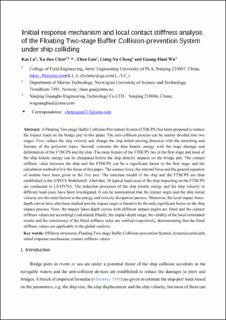| dc.description.abstract | A floating two-stage buffer collision-prevention system (FTBCPS) has been proposed to reduce the impact loads on the bridge pier in this paper. The anti-collision process can be mainly divided into two stages. First, reduce the ship velocity and change the ship initial moving direction with the stretching and fracture of the polyester ropes. Second, consume the ship kinetic energy with the huge damage and deformation of the FTBCPS and the ship. The main feature of the FTBCPS lies in the first stage and most of the ship kinetic energy can be dissipated before the ship directly impacts on the bridge pier. The contact stiffness value between the ship and the FTBCPS can be a significant factor in the first stage and the calculation method of it is the focus of this paper. The contact force, the internal force and the general equation of motion have been given in the first part. The structure model of the ship and the FTBCPS are then established in the ANSYS Workbench. After that, 38 typical load cases of the ship impacting on the FTBCPS are conducted in LS-DYNA. The reduction processes of the ship kinetic energy and the ship velocity in different load cases have been investigated. It can be summarized that the impact angle and the ship initial velocity are the main factors in the energy and velocity dissipation process. Moreover, the local impact force-depth curves have also been studied and the impact angle is found to be the only significant factor on the ship impact process. Next, the impact force-depth curves with different impact angles are fitted and the contact stiffness values are accordingly calculated. Finally, the impact depth range, the validity of the local simulation results and the consistency of the fitted stiffness value are verified respectively, demonstrating that the fitted stiffness values are applicable in the global analysis. | en_US |
